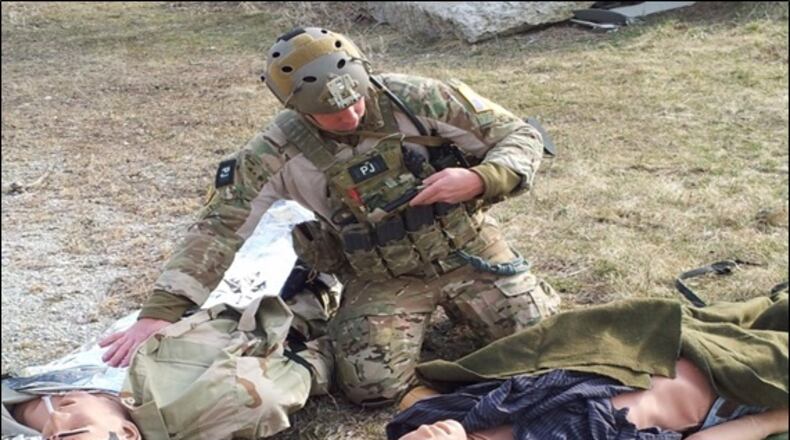AFRL researchers rely heavily on operational users and their experiences to further improve BATDOK and its ability to improve care delivery in deployed environments.
Currently, BATDOK is under user evaluations by several units, including Air Force Pararescuemen and Army Rangers to document treatment at the point of injury. Versions of BATDOK are also used across the Air Force to monitor vitals in training scenarios, such as in survival, evasion, resistance and escape training.
“BATDOK has been in countless full-mission profiles and field exercises,” said Capt. Dalton Miller, Battlefield Air Targeting Man-Aided Knowledge program manager at the 711th HPW. “We have operators who deploy using BATDOK and come back with valuable feedback we use to improve its utility.”
As Miller explains, BATDOK’s greatest advantage is its open architecture, meaning the software can easily be updated. It also means the program can adapt to emerging needs and demands, integrating with other electronic health record systems and patient monitoring sensors as they come into use in the field.
“Having this flexibility with BATDOK’s open architecture enables medics to leverage BATDOK’s capabilities without the need of carrying custom hardware,” said Miller. “This flexible platform also allows us to tailor every button, view and input mechanism to the needs of the dismounted medic. And having this operator-centric interface will then improve care downrange.”
Key advancements
Based on user feedback, AFRL researchers are working to make BATDOK even easier for deployed medics to use in the field.
With what AFRL researchers call BATDOK’s “look-free” capability, medics can quickly gather patient information automatically. BATDOK gathers information from sensors on the patient without the medic having to take any action.
“For example, a medic can run up to a patient, pull a sensor from his pouch to place on a patient, and the sensor will automatically make a patient record on the BATDOK device,” said Burnett. “While the medic is going through initial triaging, BATDOK is working in the background documenting the patient’s vitals. The medic does not have to open the application to enter information and can focus on providing life-saving care.”
Through the Emergency Trauma Dynamic Reference Library, BATDOK provides medics with a library of medical information and digitized protocols. Medics can customize the library to fit specific skills and mission requirements. With this library, medics can select the information they need to have on hand.
BATDOK also provides medics with access to customized, digitized medical standard of care guidelines and procedures. The program covers most common battlefield procedures, such as traumatic brain injury and burn resuscitation, and walks through the care procedures in a step-by-step manner.
“This feature works like a digital assistant, which is especially important in some of the most critical situations where reach-back communication is limited,” said Miller. “While deployed medics are fully trained and capable of delivering care in challenging environments, it can be helpful to have guidance when dealing with the chaos of triaging and delivering care downrange.”
Future of BATDOK
As AFRL researchers get more user feedback, they will continue to improve BATDOK, equipping it with necessary enhancements to meet the demands of the deployed medic and advancing point-of-injury care. This includes expanding BATDOK’s documentation capability beyond the point of injury to tailor its use throughout the continuum of care, from the battlefield to the clinic.
“BATDOK has proven effective around the world in austere locations and is truly built with the medic in mind and designed to improve their capabilities,” said Burnett. “BATDOK’s open architecture design promotes its future scalability as new systems come online to meet today’s mission and establishes a solid foundation to support future readiness needs for medical Airmen around the world.”
About the Author
